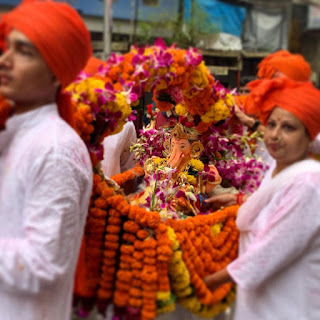Here’s the thing, being a Bombay (what it was called then) boy, growing up a kilometer away from the city’s first public Ganesh pandal, one could never ignore the impact of the magical festival of Ganesh Chaturthi.
Over decades of visiting major Ganesh Pandals in the island city and watching them evolve over the years, I learnt some extremely insightful lessons about marketing.
At the most basic level, the job profiles of a Ganesh Mandal President and the CEO of a consumer company aren’t too different. The goal is to attract maximum people to your offering vs competitors and ensure they return every year.
Here’s how Ganesh Pandal owners aced every theory in marketing using native intelligence -
1. Traditional Marketing - My product/brand is better than my competitors:
This was around the time when I first started visiting pandals as a child between from early 90s to 2000. What excited me most was the size of the idol. Tall idols of 30, 35 and even 40 feet in Ganesh Galli, Lalbaug and Khetwadi 11th Lane, would attract the maximum number of people. This slowly evolved into best decorated pandals attracting most crowds. I distinctly remember standing in queues outside Tilak Nagar’s Ganesh Pandal to get a glimpse of life size recreations of famous Indian monuments.
This I later understood, wasn’t very different from the “meri safedi uski safedi se safed” - school of marketing. The best idol, the best decoration attracted the most footfalls.
2. Modern Marketing - My product/brand is better because it makes you feel better.
The key drawback of the traditional technique of positioning above competitors was, the risk of losing loyalty. Easy for competitors to make taller idols, more elaborate decorations to veer crowds away from the incumbents. A relatively more stable model would be to shift focus away from the competitors to the consumers (in this case, devotees). Lalbaugcha Raja, to my mind, aced this strategy. The focus was always on how devotees felt with the Lord watching over them. Consistency in the design of the idol, decorations and the rituals (including a 20 hour long immersion procession) bred familiarity among devotees. While visitors attended other Pandals for to see large idols and decorations, a visit to Lalbaugcha Raja always meant much more than that. This feeling, in the material world is eerily similar to how one feels about the purchase of an Apple product. The brand is good, because it cares the most about customers, it makes them feel the best. Over time, following Apple’s lead, we’ve seen traditional marketers move more towards consumer obsession and cult - creation in their communication too.
3. “Go Green” Marketing - My product/brand is the best because it makes the world a better place.
Customer obsession eventually evolved from an individual focus to the focus on community. Over the last 5 years, I’ve noticed an increasing presence of Eco-friendly Ganesh Pandals. A few around my house in Marine Lines, speak about Zero Pollution, 100% Recyclable and Bio-degradable idols and decorations. There’s a growing cult around idols made out of Chocolate, Papier Mache and Traditional clay with water colours. This coincides with what I see around the material world too. Brands like Allbirds, Patagonia and Beyond Meat are almost exclusively based on the premise of making the world a better place for our future generations. I believe, this is also where all other brands will eventually move too. Increasingly, we hear Apple speak about re-cycling all the metals for new phones and Amazon wanting to reduce the usage of plastic in their packaging. Even hotel chains are promoting responsible, eco-friendly luxury to engage with guests and cultivate loyalty. Great move, for the earth and the customers.
4. Socially Conscious Marketing - My product/brand is best because it takes the Right Steps for Society.
Finally, this morning I read that Lalbaugcha Raja has decided against holding elaborate celebrations this year due to the Covid-19 pandemic. Instead, the authorities will devote those 10 days towards organizing blood donation and plasma therapy camps. This move, based on the reactions online, has been welcome and widely appreciated by the public. This closely follows developments around the world. Nike, J&J and Unilever have made some serious changes to their communication and product offerings in the wake of #BlackLivesMatter. In fact, Suresh Narayanan of Nestle also told CNBC-TV18, that brands are now realizing that beyond profits, they also have a big responsibility toward societal values.
Thus, here’s marketing 101, learnt from my favorite festival. Years ago, I started by visiting these Pandals as an excited child and now I continue to visit them, as an observer of marketing trends, still excited and hoping that Mighty Ganesha continues to pave the way and remove obstacles towards learning new things.






No comments:
Post a Comment